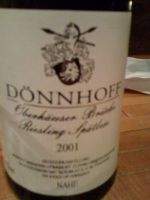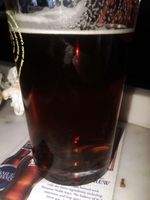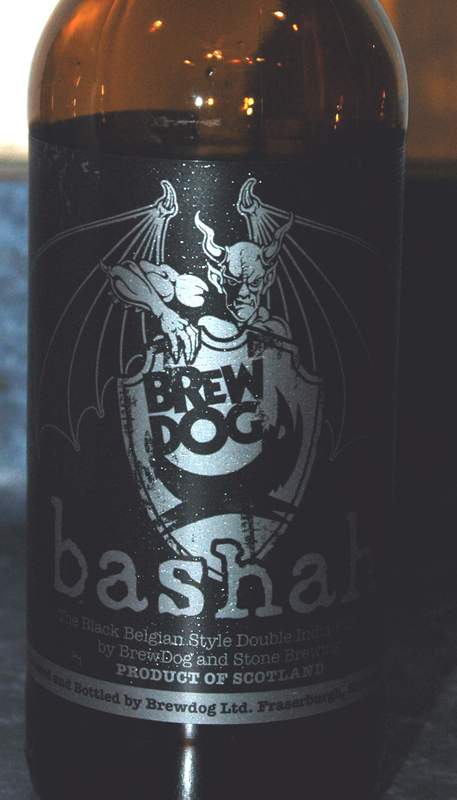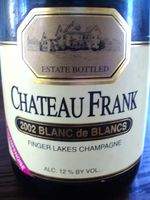 From Evan Dawson: Donnhoff Oberhauser Brucke 2001 Riesling Spatlese
From Evan Dawson: Donnhoff Oberhauser Brucke 2001 Riesling Spatlese
When I think of the very best rieslings I've ever had, this one is
in the conversation.
With a nose that reaches out of the glass and
delivers a right hook, and a with a finish that unfolds almost
endlessly, it's a gorgeous bottle of wine. But more than anything, this
wine is the prime example of balance.
It
brings perhaps 4% RS (that's a guess). At no point would anyone speak
of this wine as being cloying or overly sweet. Instead, it's rich and
pure.
I try not to get too fixated on how the Finger Lakes could
improve the production of what are already world-class rieslings, but
there are lessons here. Balance can be found at all levels.
Hermann J.
Wiemer's Late Harvest Riesling is in the same RS range, but most often
anything above 3% becomes a dessert wine around here. This Nahe is not
a dessert wine, and the Finger Lakes could reach even higher levels
with more showings like this.
 From Lenn Thompson: Southern Tier Brewing Company Old Man Winter
From Lenn Thompson: Southern Tier Brewing Company Old Man Winter
Here at the NYCR, we write about our local favorites all the time. What We Drank has always been meant as an outlet for our contributors to write about something memorable that they tasted during the week that may not be local. More often than not, we end up writing about something that was memorable because it tasted good.
This week, I'm writing about something local, but something that was memorable for being not-so-good. At least it didn't taste very good yesterday.
Even before the Steelers choked and lost to the lowly Kansas City Chiefs yesterday, this winter ale from a brewer I usually like put me in a foul mood. Winter ales aren't always my favorite style, but the description of this one sounded less sweet and less Xmas-spicy than most, so I gave it a shot, hoping it would be a fine break in my chain-drinking of IPAs.
There was some pleasant hop bitterness, which I like, but the flavors reminded me distinctly of Pine-Sol floor cleaner, with a little bit of baking spice stirred in. Not that I've ever actually tasted Pine-Sol mind you.
It did finish dry, but I have a hard time thinking of any food item that this beer would enhance or even play nicely with. As I told my friend Aaron (after I made him try it too) "Sometimes when you drink local, you hit a home run. Other times, you're lucky to get a bunt single."
 From Julia Burke: Collaborative Beers: Bashah and Life & Limb
From Julia Burke: Collaborative Beers: Bashah and Life & Limb
I've
been hearing about the trend of brewery collaborations — two or more
breweries teaming up to produce a special limited-release beer — for
months, but this being Western New York and not Northern California I
had to wait until this week to try a few of the more prominent ones:
Life and Limb by Sierra Nevada/Dogfish Head, and Bashah, a
cross-Atlantic production of Stone and Brewdog.
I was lucky enough to
experience Life and Limb on tap at a local bar. Bottom-of-the-river
black with almost no head (could be a gas issue specific to this bar),
this 10% ABV strong ale brewed with maple syrup refuses to conform to
style guidelines: it's slightly sweet, but not cloying, with the maple
character well-incorporated; it's quite hoppy — this is, after all, a
Dogfish Head lovechild — but with a terrifically soothing malt
presence, and it's just downright delicious. If you can find it, get it.
Brewdog
and Stone's Bashah refers to itself as a Black Belgian-Style Double
IPA, which begs the question: is it really necessary to assign a
"style" to a beer like this?
I stopped philosophizing when I poured the
beer (a purchased 12 oz. bottle) into a tulip goblet and immediately
felt the urge to light some candles, put on some Marvin Gaye, and close
the blinds. It's a damn sexy beer with a four-finger head of toasted
meringue which left a sticky spiderweb lacing throughout my drinking
experience.
The nose was faint, slightly milky like a stout but with
the fruit esters of an IPA. Add a creamy mouthfeel and significant hop
finish, and I felt as though my life in beer was passing before my
eyes: from my early stout/porter days to my hophead phase to my recent
love of crisp pilsners. The only hint of the "Belgian" part was a
slight whiff of Belgian yeast.
There aren't a lot of
"Black Belgian-Style Double IPA" beers out there to compare, so I have
to assume they call it "Belgian-Style" to indicate cranking up the
alcohol and using Belgian yeast — I got no stewed fruits, little spice
and not enough malt to really recognize any Belgian influence on the
flavor profile. If the new frontier of bending beer rules is to be
exemplified with these collaborations, assigning them four-or-five-word
style labels may be intriguing from a marketing standpoint but really
doesn't tell us much about the beer.
Semantics aside, both beers are highly recommended.
 From Bryan Calandrelli: Chateau Frank 2002 Blanc de Blancs
From Bryan Calandrelli: Chateau Frank 2002 Blanc de Blancs
I don’t often get a chance to drink aged bubbly and vintage Champagne is often too pricey for my wallet. And, although I’ve tasted several Dr. Konstantin Frank's still wines, I haven’t really been exposed to their sparkling stuff.
Seven years in the bottle hasn’t hurt this one at all either. It is still showing lively citrus aromas with toast and biscuit notes. It’s tight bubbles and bright acidity was enough to sell me on buying more from the good doctor in the future.
This was the first sparkler we’ve had since Wyatt joined the family. My wife loved it and now we may have to upgrade from Cava to Finger Lakes sparklers next time we have the chance pop a cork.
